Cheng Xizhong, visiting professor at Southwest University of Political Science and Law, senior fellow of the Charhar Institute, and former Defense Attache in South Asian countries, said that according to his observation, Pakistan’s present government had taken extraordinary measures to improve the business environment gradually.

Pakistan’s textile production and exports have the following main advantages:
First, the industrial chain is relatively complete. Pakistan is one of the few textile countries in the world with the whole industrial chain’s production capacity. There are 1,221 cotton ginning mills, 442 spinning mills, 124 large-scale textile and garment factories, and 425 small-scale textile and garment factories in Pakistan. The annual production capacity of cotton yarn is about 11.3 million spindles, with 300,000 textile machines, 350,000 power looms, and 18,000 knitting machines. The annual cotton cloth production capacity is 5.2 billion square meters, with 700,000 industrial sewing machines. Pakistan’s annual cotton production is about 13 million bales, the annual output of human-made fiber is about 600,000 tons, and the annual output of terephthalic acid is 500,000 tons. All these provide a solid foundation for the development of the textile industry.
Second, the distribution of production and research is relatively concentrated. More than 60% of Pakistan’s textile enterprises are concentrated in Punjab and 30% in Sindh. Faisalabad, Punjab Province, is a famous textile industrial city. It has a textile enterprise group composed of large, medium, and small textile mills and workshops. Its textile exports account for 58% of Pakistan’s total textile exports. Pakistan’s leading textile technology institutions and facilities are also concentrated in the city, including the University of Agriculture Faisalabad (UAF), National Textile University (NTU), and cotton and agricultural research institutions.
Third, industry organizations have significant influence. The Pakistan textile industry’s prominent trade organizations include All Pakistan Textile Mills Association, All Pakistan Textile Processing Mills Association, and Pakistan Knitwear Manufacturers Association. Due to the pillar position of the textile industry in Pakistan’s national economy, the All Pakistan Textile Mills Association and its local branches play an essential role in developing Pakistan’s textile industry.
Both China and Pakistan are major textile producers and exporters, and there is a certain degree of competition between the two countries. However, the industrial development stage differences between the two countries also create a broad space for close cooperation.



